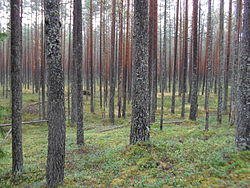Agusalu | |
|---|---|
Village | |
 | |
 Interactive map of Agusalu | |
| Country | |
| County | Ida-Viru County |
| Parish | Alutaguse Parish |
| Time zone | UTC+2 (EET) |
| • Summer (DST) | UTC+3 (EEST) |
Agusalu is a village in Alutaguse Parish, Ida-Viru County in northeastern Estonia. [1] It is particularly known for the Agusalu Nature Reserve, which encompasses a large proportion of the area. Its landscape is characterised by large bogs and is known for hosting the only system of continental sand dunes in Estonia. [2]
